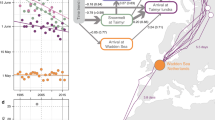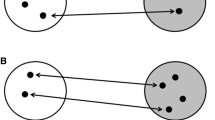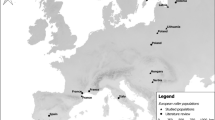Abstract
Seasonal migration is ubiquitous in animals, and yet its underlying cause(s) remain poorly known. Species exhibiting short-distance altitudinal migration and intraspecific variation in migratory behavior (partial or differential migration) are ideal study systems for examining the selective pressures that affect individual migratory decisions. We used an individually marked population of yellow-eyed juncos, breeding along a 1000-m elevational gradient and migrating up and down that gradient, to examine the morphological, behavioral, and reproductive traits associated with migratory behavior. We tested the four most well-known hypotheses proposed to explain partial migration: the thermal tolerance, fasting endurance, dominance, and arrival time hypotheses. Our results indicate that: (1) limits to juncos’ fasting endurance constrain their ability to overwinter at high elevations, in support of the fasting endurance hypothesis, (2) differences in body size mediate fasting ability and are associated with variation in migratory behavior and overwinter apparent survival, (3) migratory behavior interacts with reproductive success, in partial support of the arrival time hypothesis, and (4) additional mechanisms that are not captured by the four well-known hypotheses might better explain individual variation in migratory behavior. Less migratory females achieved greater nesting success the following breeding season. Among males, nesting success influenced migratory tendency the following winter. Successful males may either migrate to a more benign winter climate without paying reproductive costs, or high levels of parental effort might physiologically constrain their ability to overwinter in harsh climates.
Significance statement
Migration is a costly behavior, so migration must yield fitness benefits, at least for some individuals. Species in which migratory behavior varies among individuals in the same population provide an under-utilized opportunity to understand the costs and benefits that mediate individual migratory decisions. By marking and tracking a population of yellow-eyed juncos, we found that larger individuals were less likely to migrate, and this held true even within a sex class (males). Smaller individuals were not only more likely to migrate but also had lower apparent survival, and these differences were driven by size-related differences in fasting ability. Less migratory females accrued reproductive benefits, but males with the highest reproductive success were not less likely to migrate as predicted by the arrival time hypothesis. Our study demonstrates that migratory decisions balance the potential reproductive benefits and survival risks of overwintering on high-elevation breeding grounds.





Similar content being viewed by others
References
Adriaensen F, Dhondt AA (1990) Population dynamics and partial migration of the European Robin (Erithacus rubecula) in different habitats. J Anim Ecol 59:1077–1090
Balph MH, Balph DF, Romesburg HC (1979) Social status signaling in winter flocking birds: an examination of a current hypothesis. Auk 96:79–83
Barçante L, Vale MM, Alves MAS (2017) Altitudinal migration by birds: a review of the literature and a comprehensive list of species. J Field Ornithol 88:321–335
Barton (2017) MuMIn: Multi-model Inference. R package version 1.43.6. https://CRAN.R-project.org/package=MuMIn
Bearhop S, Hilton GM, Votier SC, Waldron S (2004) Stable isotope ratios indicate that body condition in migrating passerines is influenced by winter habitat. Proc R Soc Lond B 271:S215–S218
Belthoff JR, Gauthreaux SA Jr (1991a) Aggression and dominance in house finches. Condor 93:1010–1013
Belthoff JR, Gauthreaux SA Jr (1991b) Partial migration and differential winter distribution of house finches in the eastern United States. Condor 93:374–382
Berthold P (1996) Control of bird migration. Chapman and Hall, London
Berthold P (1999) A comprehensive theory for the evolution, control, and adaptability of avian migration. Ostrich 70:1–11
Berthold P (2001) Bird migration: a general survey, 2nd edn. Oxford University Press, Oxford
Biebach H (1983) Genetic determination of partial migration in the European robin (Erithacus rebecula). Auk 100:601–606
Bosman DS, Vercruijsse HJP, Stienen EWM, Vincx M, De Neve L, Lens L (2012) Effects of body size on sex-related migration vary between two closely related gull species with similar size dimorphism. Ibis 154:52–60
Boyle WA (2008) Partial migration in birds: tests of three hypotheses in a tropical lekking frugivore. J Anim Ecol 77:1122–1128
Boyle WA (2011) Short-distance partial migration of neotropical birds: a community-level test of the foraging limitation hypothesis. Oikos 120:1803–1816
Boyle WA (2017) Altitudinal bird migration in North America. Auk 134:443–465
Boyle WA, Conway CJ (2007) Why migrate? A test of the evolutionary precursor hypothesis. Am Nat 169:344–359
Boyle WA, Norris RD, Guglielmo CG (2010) Storms drive altitudinal migration in a tropical bird. Proc R Soc Lond B 277:2511–2519
Boyle WA, Guglielmo CG, Hobson KA, Norris DR (2011) Lekking birds in a tropical forest forego sex for migration. Biol Lett 7:661–663
Burnham KP, Anderson DR (2002) Model selection and multimodel inference: a practical information-theoretic approach, 2nd edn. Springer-Verlag, New York
Calder WA (1974) Consequences of body size for avian energetics. In: Paynter RA (ed) Avian energetics. Nuttall Ornithological Club Publ., Cambridge
Cam E, Link WA, Cooch EG, Monnat J-Y, Danchin E (2002) Individual variation in life-history traits: seeing the trees despite the forest. Am Nat 159:96–105
Catry P, Campos A, Alanda V, Cresswell W (2004) Winter segregation of migrant European robins Erithacus rebecula in relation to sex, age, and size. J Avian Biol 35:204–209
Chambon R, Dugravot S, Paillisson J, Lemesle J, Ysnel F, Gélinaud G (2018) Partial migration in inexperienced pied avocets Recurvirostra avosetta: distribution pattern and correlates. J Avian Biol 49:e01549
Chapman BB, Brönmark C, Nilsson J, Hansson L-A (2011) The ecology and evolution of partial migration. Oikos 120:1764–1775
Creighton E (2001) Mate acquisition in the European blackbird and its implications for sexual strategies. Ethol Ecol Evol 13:247–260
Cristol DC, Baker MB, Carbone C (1999) Differential migration revisited: latitudinal segregation by age and sex class. Curr Ornithol 15:33–87
Davies NB (1978) Territorial defense in the speckled wood butterfly, Pararge aegeria: the resident always wins. Anim Behav 26:138–147
Dokter AM, Farnsworth A, Fink D, Ruiz-Gutierrez V, Hochachka WM, La Sorte FA, Robinson OJ, Rosenberg KV, Kelling S (2018) Seasonal abundance and survival of North America’s migratory avifauna determined by weather radar. Nat Ecol Evol 2:1603–1609
Duckworth RA (2006) Behavioral correlations across breeding contexts provide a mechanism for a cost of aggression. Behav Ecol 17:1011–1019
Fleischer RC, Johnston RF (1984) The relationship between winter climate and selection on body size of house sparrows. Can J Zool 62:405–410
Fontaine JJ, Martel M, Markland HM, Niklison AM, Decker KL, Martin TE (2007) Testing ecological and behavioral correlates of nest predation. Oikos 116:1887–1894
Fretwell SD (1969) Dominance behavior and winter habitat distribution in juncos (Junco hyemalis). Bird Band 40:1–83
Fretwell SD (1972) Populations in a seasonal environment. Princeton University Press, Princeton
Fudickar AM, Schmidt A, Hau M, Quetting M, Partecke J (2013) Female-biased obligate strategies in a partially migratory population. J Anim Ecol 82:863–871
Gauthreaux SA Jr (1982) The ecology and evolution of avian migration systems. In: Farner DS, King JR (eds) Avian biology 6. Academic Press, New York, pp 93–167
Gill JA, Norris K, Potts PM, Gunnarsson TG, Atkinson PW, Sutherland WJ (2001) The buffer effect and large-scale population regulation in migratory birds. Nature 412:436–438
Gillis EA, Green DJ, Middleton HA, Morrissey CA (2008) Life history correlates of alternative migratory strategies in American dippers. Ecology 89:1687–1695
Gow EA, Wiebe KL (2014) Males migrate farther than females in a differential migrant: an examination of the fasting endurance hypothesis. R Soc Open Sci 1:1–8
Greenberg R, Marra PP (2005) Birds of two worlds: the ecology and evolution of migration. John Hopkins University Press, Baltimore
Grist H, Daunt F, Wanless S, Nelson EJ, Harris MP, Newell MA, Burthe SJ, Reid JM (2014) Site fidelity and individual variation in winter location in partially migratory European shags. PLoS One 9:e98562
Grist H, Daunt F, Wanless S, Burthe SJ, Newell MA, Harris MP, Reid JM (2017) Reproductive performance of resident and migrant males, females, and pairs in a partially migratory bird. J Anim Ecol 86:1010–1021
Guillemain M, Hearn R, King R, Gauthier-Clerc M, Simon G, Caizergues A (2009) Differential migration of the sexes cannot be explained by the body size hypothesis in teal. J Ornithol 150:685–689
Heckscher CM, Ramirez MG, Kneidel AH (2017) Reproductive outcomes determine the timing of arrival and settlement of a single-brooded Nearctic-Neotropical songbird (Catharus fuscescens) in South America. Auk 134:842–856
Hegemann A, Marra PP, Tieleman NI (2015) Causes and consequences of partial migration in a passerine bird. Am Nat 186:531–546
Hegemann A, Fudickar AM, Nilsson JA (2019) A physiological perspective on the ecology and evolution of partial migration. J Ornithol 160:893–905
Higginson AD, McNamara JD, Houston AI (2012) The starvation-predation trade-off predicts trends in body size, muscularity, and adiposity between and within taxa. Am Nat 179:338–350
Horvath EG, Sullivan KA (1988) Facultative migration in yellow-eyed juncos. Condor 90:482–484
Jahn AE, Levey DJ, Hostetler JA, Mamani AM (2010) Determinants of partial bird migration in the Amazon Basin. J Anim Ecol 79:983–992
Järvi T, Røskaft E, Bakken M, Zumsteg B (1987) Evolution of variation in male secondary characteristics: a test of eight hypotheses applied to pied flycatchers. Behav Ecol Sociobiol 20:161–169
Kaiser L (1983) Unbiased estimation in line-intercept sampling. Biometrics 39:965–976
Kendeigh SC (1945) Resistance to hunger in birds. J Wildlife Manage 9 (3):217
Ketterson ED (1979) Status signaling in dark-eyed juncos. Auk 96:94–99
Ketterson ED, Nolan V Jr (1976) Geographic variation and its climatic correlates in the sex ratio of eastern-wintering dark-eyed juncos (Junco hyemalis hyemalis). Ecology 57:679–693
Ketterson ED, Nolan V Jr (1983) The evolution of differential bird migration. Curr Ornithol 1:357–402
Kirkpatrick C, Conway CJ (2010) Nest predators of ground-nesting birds in montane forests of the Santa Catalina Mountains, Arizona. Wilson J Ornithol 122:614–617
Klaassen RHG, Hake M, Strandberg R, Koks BJ, Trierweiler C, Exo KM, Bairlein F, Alerstam T (2014) When and where does mortality occur in migratory birds? Direct evidence from long-term satellite tracking of raptors. J Anim Ecol 83:176–184
Kokko H (2011) Directions in modelling partial migration: how adaptation can cause a population decline and why the rules of territory acquisition matter. Oikos 120:1826–1837
Kokko H, Gunnarsson TG, Morrell LJ, Gill JA (2006) Why do female migratory birds arrive later than males? J Anim Ecol 75:1293–1303
Lack D (1943) The problem of partial migration. Brit Birds 37:122–131
Lehikoinen E (1986) Dependence of winter survival on size in the great tit Parus major. Ornis Fennica 63:10–16
Lima SL (1986) Predation risk and unpredictable feeding conditions of body mass in birds. Ecology 67:377–385
Lok T, Veldhoen L, Overdijk O, Tinbergen JM, Piersma T (2017) An age-dependent fitness cost of migration? Old trans-Saharan migrating spoonbills breed later than those staying in Europe, and late breeders have lower recruitment. J Anim Ecol 86:998–1009
Lundberg P (1985) Dominance behaviour, body weight and fat variations, and partial migration in European blackbirds Turdus merula. Behav Ecol Sociobiol 17:185–189
Lundberg P (1988) The evolution of partial migration in birds. Trends Ecol Evol 3:172–175
Lundberg P, Schwabl H (1983) Structure and dominance behaviour of a partial migratory population of Blackbirds Turdus merula during the non-breeding season. Ornis Fennica Suppl 3:20–21
Lundblad CG (2014) Altitudinal migration in birds: tests of four mechanistic hypotheses in yellow-eyed juncos (Junco phaeonotus). MSc thesis, University of Arizona
Lundblad CG, Conway CJ (2020) Variation in selective regimes drives intraspecific variation in life history traits and migratory behavior along an elevational gradient. J Anim Ecol 89 (published online. https://doi.org/10.1111/1365-2656.13134
Macdonald CA, McKinnon EA, Gilchrist HG, Love OP (2016) Cold tolerance, and not earlier arrival on breeding grounds, explains why males winter further north in an arctic-breeding songbird. J Avian Biol 47:7–15
Marra PP, Hobson KA, Holmes RT (1998) Linking winter and summer events in a migratory bird using stable carbon isotopes. Science 282:1884–1886
McDonald JE (1956) Variability of precipitation in an arid region: a survey of characteristics for Arizona. University of Arizona, Institute for Atmospheric Physics, Technical Reports on the Meterology and Climatology of Arid Regions No. 1, Tucson
Middleton HA, Morrissey CA, Green DJ (2006) Breeding territory fidelity in a partial migrant, the American dipper, Cinclus mexicanus. J Avian Biol 37:169–178
Moore NJ (1972) Ethology of the Mexican Junco (Junco phaeonotus palliatus). Dissertation. University of Arizona
Morton ML (1984) Sex and age ratios in wintering white-crowned sparrows. Condor 86:85–87
National Weather Service (2017a) Monthly rainfall normals (1981–2010) across southeast Arizona, https://www.wrh.noaa.gov/twc/climate/seaz_rainfall_normals.php . Accessed 10 Oct 2017
National Weather Service (2017b) Monthly climate report for Tucson, https://www.wrh.noaa.gov/twc/ climate/monthly.php
Nebel S (2006) Latitudinal clines in sex ratio, bill, and wing length in least sandpipers. J Field Ornithol 77:39–45
Newton I (2008) The migration ecology of birds. Elsevier, Oxford
Newton I (2012) Obligate and facultative migration in birds: ecological aspects. J Ornithol 153:S171–S180
Nolan V Jr (1978) The ecology and behavior of the prairie warbler, Dendroica discolor. Ornithol Monogr 26:1–595
Norberg R (1981) Temporary weight decrease in breeding birds may result in more fledged young. Am Nat 118:838–850
Norbu N, Wikelski MC, Wilcove DS, Partecke J, Tenzin U, Tempa T (2013) Partial migration of Himalayan forest pheasant. PLoS One 8:e60979
Norris DR, Marra PP, Kyser TK, Sherry TW, Ratcliffe L (2004) Tropical winter habitat limits reproductive success on the temperate breeding grounds in a migratory bird. Proc R Soc Lond B 271:59–64
Ogonowski MS, Conway CJ (2009) Migratory decisions in birds: extent of genetic versus environmental control. Oecologia 161:199–207
Pachauri RK, Allen MR, Barros VR et al (2014) Climate change 2014: synthesis report. Contribution of working groups I, II and III to the fifth assessment report of the Intergovernmental Panel on Climate Change. IPCC, Geneva
Palacín C, Alonso JC, Alonso JA, Magaña M, Martin CA (2011) Cultural transmission and flexibility of partial migration patterns in a long-live bird, the great bustard Otis tarda. J Avian Biol 42:301–308
Perez C, Granadeiro JP, Dias MP, Alonso H, Catry P (2014) When males are more inclined to stay at home: insights into the partial migration of a pelagic seabird provided by geolocators and isotopes. Behav Ecol 25:313–319
Perrins CM, Harris MP, Britton CK (1973) Survival of manx shearwaters Puffinus puffinus. Ibis 115:535–548
Phillips AR, Marshall J, Monson G (1964) Birds of Arizona. University of Arizona Press, Tucson
Pratt AC, Smith KT, Beck JL (2017) Environmental cues used by greater sage-grouse to initiate altitudinal migration. Auk 134:628–643
Prescott DRC (1990) Age and sex differences in winter distribution of American goldfinches in eastern North America. Ornis Scand 21:99–104
Prescott DRC (1994) Intraspecific and geographical trends in body size of a differential migrant, the evening grosbeak. Auk 111:693–702
R Core Team (2017) R: a language and environment for statistical computing. R Foundation for Statistical Computing, Vienna. https://www.R-project.org
Ralph CJ, Geupel GR, Pyle P, Martin TE, DeSante DF (1993) Handbook of field methods for monitoring landbirds. U.S. Forest Service, Pacific Southwest Research Station, Albany, CA
Rising JD, Somers KM (1989) The measurement of overall body size in birds. Auk 106:666–674
Runge MC, Marra PP (2005) Modeling seasonal interactions in the population dynamics of migratory birds. In: Greenberg RS, Marra PP (eds) Birds of two worlds: the ecology and evolution of migration. John Hopkins University Press, Baltimore
Schwabl H (1983) Expression and significance of the winter strategies in a partially migratory population of European blackbirds (Turdus merula). J Ornithol 124:101–116
Shepherd PCF, Lank DB, Smith BD, Warnock N, Kaiser GW (2001) Sex ratios of Dunlin wintering at two latitudes on the pacific coast. Condor 103:352–360
Sih A, Bell A, Johnson JC (2004) Behavioral syndromes: an ecological and evolutionary overview. Trends Ecol Evol 19:372–378
Sillett TS, Holmes RT (2002) Variation in survivorship of a migratory songbird throughout its annual cycle. J Anim Ecol 71:296–308
Sogge MK, Koronkiewicz TJ, van Riper CIII, Durst SL (2007) Willow flycatcher nonbreeding territory defense behavior in Costa Rica. Condor 109:475–480
Somveille M, Rodrigues ASL, Manica A (2015) Why do birds migrate? A macroecological perspective. Glob Ecol Biogeogr 24:664–674
Strandberg R, Klaassen RHG, Hake M, Alerstam T (2010) How hazardous is the Sahara Desert crossing for migratory birds? Indications from satellite tracking of raptors. Biol Lett 6:297–300
Terrill SB (1991) Evolutionary aspects of orientation and migration in birds. In: Berthold P (ed) Orientation in Birds. Birkhäuser Verlag, Basel, pp 180–201
Terrill SB, Able KP (1988) Bird migration terminology. Auk 105:205–206
Tobias J (1997) Asymmetrical territorial contests in the European robin: the role of settlement costs. Anim Behav 54:9–21
Western Regional Climate Center (2017) Period of record monthly climate summary for Mt. Lemmon Arizona, https://wrcc.dri.edu/cgi-bin/cliMAIN.pl?az5732. . Accessed 10 Oct 2017
Wikelski M, Tarlow EM, Raim A, Diehl RH, Larkin RP, Visser GH (2003) Costs of migration in free-flying songbirds. Nature 423:704
Winger BM, Auteri GG, Pegan TM, Weeks BC (2018) A long winter for the red queen: rethinking the evolution of seasonal migration. Biol Rev 94:737–752
Witter MS, Cuthill IC (1993) The ecological costs of fat storage. Philos Trans R Soc B 340:73–92
Zeileis A, Hothorn T (2002) Diagnostic checking in regression relationships. R News 2:7–10 https://CRAN.R-project.org/doc/Rnews/
Zúñiga D, Gager Y, Kokko H, Fudickar AM, Schmidt A, Naef-Daenzer B, Wikelski M, Partecke J (2017) Migration confers winter survival benefits in a partially migratory songbird. eLife 6:1–12
Acknowledgments
A. Boyle and R. Duckworth provided invaluable feedback and support throughout the development and implementation of this study. R. Norris and three anonymous reviewers provided suggestions that improved the manuscript. Any use of trade, firm, or product names is for descriptive purposes only and does not imply endorsement by the U.S. Government.
Funding
CGL was supported by National Science Foundation Graduate Research Fellowship No. DGE-1143953. Arizona Field Ornithologists, T&E Inc., and Western Bird Banding Association provided funding.
Author information
Authors and Affiliations
Corresponding author
Ethics declarations
Conflict of interest
The authors declare that they have no conflict of interest.
Ethical approval
All applicable international, national, and institutional guidelines for the use and care of animals were followed. This study was performed under a protocol approved by the University of Arizona Institutional Animal Care and Use Committee (protocol no.11-272).
Additional information
Communicated by W. Wiltschko
Publisher’s note
Springer Nature remains neutral with regard to jurisdictional claims in published maps and institutional affiliations.
Rights and permissions
About this article
Cite this article
Lundblad, C.G., Conway, C.J. Testing four hypotheses to explain partial migration: balancing reproductive benefits with limits to fasting endurance. Behav Ecol Sociobiol 74, 26 (2020). https://doi.org/10.1007/s00265-019-2796-3
Received:
Revised:
Accepted:
Published:
DOI: https://doi.org/10.1007/s00265-019-2796-3




